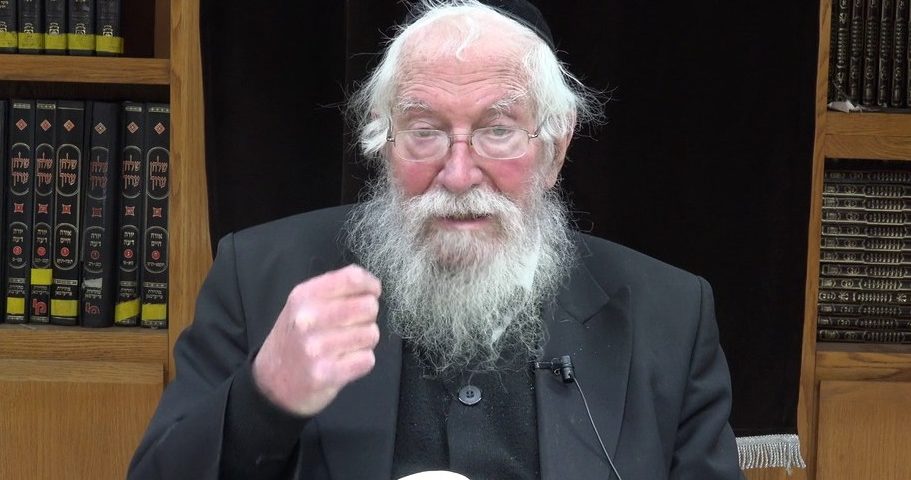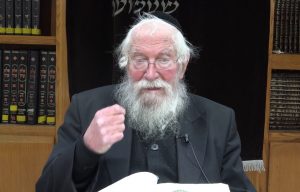Halakha Down to Earth

Halakha Down to Earth: In Memory of Rav Z.N. Goldberg
Yona Reiss
The first time that I encountered HaGaon Rav Zalman Nechemia Goldberg zt”l was when I was an American overseas student at Yeshivat Sha’alvim in the mid-1980s preparing to give my first halakhic discourse to fellow students at the yeshiva. My topic was on the issue of walking dogs on Shabbat, with all its attendant issues in terms of pet-owning, muktzeh, and carrying outdoors on Shabbat, and I was trying to assemble all the relevant source materials.
When I approached my Maggid Shiur for assistance, he pointed to the front of the Beit Midrash and said, “You see that Rav standing there? That’s Rav Zalman Nechemia Goldberg. He visits the Yeshiva once a week, and he knows the entire Torah . Ask him and he will tell you something interesting for your shiur.” I still remember being taken aback at how accessible this man who had the whole Torah at his fingertips seemed to be, and how eager he was to help. Rav Zalman Nechemia referred me to a comment by R. Akiva Eiger, in his commentary to the Mishna, questioning whether the positive commandment of having one’s animal rest on Shabbat applied equally to women, since, arguably, it is a time bound positive commandment from which women are normally exempt. Additionally, the obligation would not necessarily be included in the positive mitzva of Zakhor (remembering the Shabbat) which is incumbent upon women. Rav Zalman Nechemia advised me that it might be interesting to explore, based on this query of R. Akiva Eiger, whether certain aspects of pet-owning on Shabbat would be particularly problematic for men.
Approximately thirteen years later, I had another occasion to turn to Rav Zalman Nechemia, this time regarding a much weightier halakhic question. I had just begun working at the Beth Din of America in a part-time capacity, and a serious question arose regarding the validity of a certain Get, that had already been delivered, in light of an uncertainty regarding the way that one of the witnesses had signed his name (the details are not important for now). This issue required the determination of an internationally respected halakhic authority, and I was told by my rabbinic mentors that Rav Zalman Nechemia Goldberg fit the bill.
Not yet proficient in Hebrew typing, I feverishly wrote a seven-page handwritten summary of the urgent question at hand, citing whatever sources were familiar to me, and then proceeded to send my query to the fax number at his home. One day later my home telephone rang, and it was none other than Rav Zalman Nechemia himself, calling to reassure me that there was nothing to worry about, and that the Get was 100% kosher. In addition to noting that the witness fundamentally signed his name correctly, he added that, after all, the signing of witnesses is only required by the Talmud based on tikkun ha-olam – to make the validity of the Get more air-tight, but not based on absolute necessity. His willingness to lodge a reassuring long-distance call to a young Beth Din neophyte within one day of receiving this query was itself an emblematic act of tikkun ha-olam.
Indeed, one of the hallmarks of Rav Zalman Nechemia was his tremendous accessibility to all those who sought his advice, counsel, and mentorship. He was legendary for conferring numerous rabbinic ordinations upon students who would take his semikha examinations. In this sense, he was a strong believer of the democratic nature of the Torah – כל הרוצה ליקח יבא ויקח (see Yoma 72b) – as a legacy equally available to the entirety of the Jewish people.
Rav Zalman Nechemia also possessed a unique blend of phenomenal erudition and real-world perspicacity. When approached for his expertise on contemporary halakhic questions, he would unflinchingly tackle every issue, leaving no stone unturned in his rigorous and detailed analysis. This was evident in his correspondence over the years with the Beth Din of America regarding a variety of different issues, including the infamous kiddushei ketana case of the mid 1990s, the 9/11 Aguna cases, advice to the Beth Din regarding the contemporary value of the Ketuba, and various mamzerut related questions. His mentorship of the Eretz Hemdah Institute in Jerusalem, including its responsa project, also reflected his willingness to confront modern-day questions with courage and zeal. But he was also not hesitant to register his opinion when he felt that certain boundaries could not be traversed, such as the essay that he penned in opposition to women reciting Sheva Berakhot.
It was in large part due to his halakhic thoroughness and integrity that Rav Zalman Nechemia’s endorsement of the halakhic pre-nuptial agreement of the Beth Din of America has been viewed with such tremendous respect. Over the years, detractors tried to question his endorsement by suggesting that he had only approved an earlier and superseded form. But when mori R. Mordechai Willig, the author of the agreement, presented him with a detailed word-for-word translation of the full text of the updated form of the agreement, he heartily reiterated his endorsement, writing on the bottom of the page that he approved not only the concept of the agreement, but the entirety of the actual text as well. Similarly, when one of Rav Zalman Nechemia’s colleagues challenged his willingness to permit the couple signing the agreement to authorize the Beth Din to follow secular law customs in adjudicating the monetary aspects of the divorce, he responded decisively that the halakha permits parties to make conditions with respect to monetary matters, and that in any event one of the great virtues of the prenuptial agreement is that it provides a vehicle for divorcing couples to follow Jewish law by bringing their disputes to Beth Din rather than to a secular court.
Indeed, the passing of Rav Zalman Nechemia immediately prior to Parshat Shoftim, which deals with the appointment of Jewish law judges as well as the famous passage “Tzedek, tzedek tirdof” – of pursuing righteousness with equity in adjudicating cases (see Sanhedrin 32b) – highlights the contribution that he made through his many articles and decisions about contemporary halakhic jurisprudence. I had the privilege of speaking with Rav Zalman Nechemia on a number of occasions at the annual Halikhot Am Yisrael conference of international dayanim in Jerusalem, and his consistent theme was the application of the intricacies of halakhic discourse to the practical world of contemporary dispute resolution in the Jewish community. This was also his mantra as a long-serving dayan on the Beth Din HaGadol in Jerusalem, and a key credential of his editorship of the Encyclopedia Talmudit. He brought traditional lomdus down to earth. To appreciate his sense of practical halakha in modern Batei Din, one need only read his landmark essay “Shivhei HaPeshara,” in Mishpetai Aretz 1 (2002), available here, about the many practical advantages of deciding cases according to principles of equity and not only according to strict Jewish law.
R. Aharon Lichtenstein zt”l once told me that true Gedolim never disparage a fellow Jew. In this regard among others, Rav Zalman Nechemia Goldberg zt”l was a true Gadol. He had an immense love for Torah and for every Jew. His legacy of personal accessibility, halakhic integrity, and forward-thinking should serve as our lodestar. Yehi zikhro barukh.
Rabbi Yona Reiss, a member of the TRADITION editorial board, serves as the Av Beth Din of the Chicago Rabbinical Council and as a Rosh Yeshiva at the Rabbi Isaac Elchanan Theological Seminary, Yeshiva University, where he occupies the Rabbi L. Katz Chair in Professional Rabbinics.
[Published on August 25, 2020]

